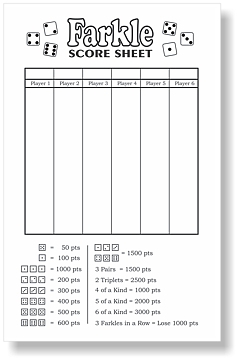

Play to 10,000: Obvious change that lengthens the game significantly. This forces players to be a little more aggressive early in the game, which is usually what players are doing anyway. Minimum score to begin: A player may not score their first points unless they have at least 1000 points on their turn. This simply avoids ultra low scores and forces players that have only been rolling single 5 spots from stopping. Minimum score to stop: A player must have at least 350 points to voluntarily stop rolling. Most of these variations deviate from that. Each makes the game more complicated to score and/or keep track of. I don't play any of these, but I've seen them. If the score is close, you may want to roll again and again until you have a significantly large score. They are now mandated to roll until they Farkle or they beat you. When you exceed 5000, you don't get another turn, but those who trail you get to play again. When approaching 5000 points, be aware of the scores of your competitors. Only the ultra-conservative player will stop rolling with all six dice in their hand. Throwing all six dice will almost always lead to at least one scoring die. Some players are always aggressive or always conservative, but the adaptive player is the one most likely to win. Conversely, if you are significantly ahead, then it is better to play conservatively than aggressively. If you are significantly behind, it is better to play aggressively than to play conservatively. For instance, if you have set aside 2 dice already, and then throw two single scoring dice (say, a 1 and a 5), then you should only take the single 1. It is better to leave yourself with three or more dice for a throw than it is to take single scoring dice.

FARKLE SCORES FULL
In the event of a tie, full rounds of turns (including all players) are played until one person has a higher score. The highest score after those last turns is the winner. Everyone else at the table gets one more turn to try and beat the score. The first player that exceeds 5000 points is done. Because of this, you can only score the Six of a kind, Straight, Three pair, or Two triples when rolling all six dice. For example, if the roller sets aside a single 5 spot and counts 50, and then on his next roll comes up with two 5 spots, he cannot count 500 for Three 5s (although he may set aside the additional as two single 5 spots for 100 points). NOTE: All scores listed are for a single throw of the dice. The scoring dice are: Single 5: 50 points By continuing to roll, the player continues to risk their points for the entire turn. If the player has set aside all six dice for scoring, then they can continue their turn by throwing all six dice anew (and keeping the score they have so far for the turn). All points from the turn are recorded, and play passes to the left. the player voluntarily stops rolling the dice.The player has farkled, the turn is over, all points for the turn are forfeited (any points recorded from previous turns are safe), and play passes to the left. the player rolls the dice (or die) and do not roll anything that scores.If there is at least one scoring die, then the player has two choices: either stop rolling and take their points, or set aside at least one die to score, continue to roll, and risk their accumulated points for that turn.Ī turn is over once one of two things has happened: If no dice can score, the turn is over and the player has Farkled. After each throw, the player must set aside at least one scoring die. At the beginning of each turn, the player throws all six dice. The object of the game is get the most points.įarkle is played in turns. For: Best with 2 players, but can be expanded limitless


 0 kommentar(er)
0 kommentar(er)
